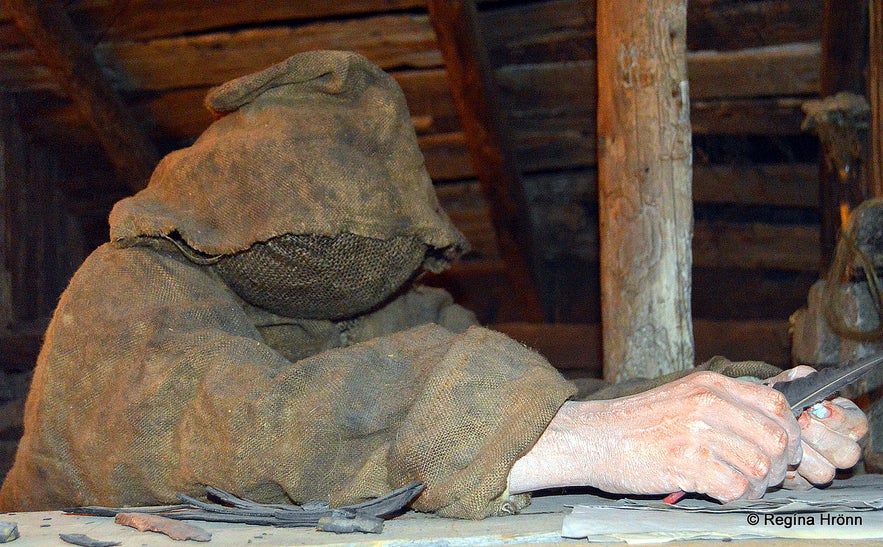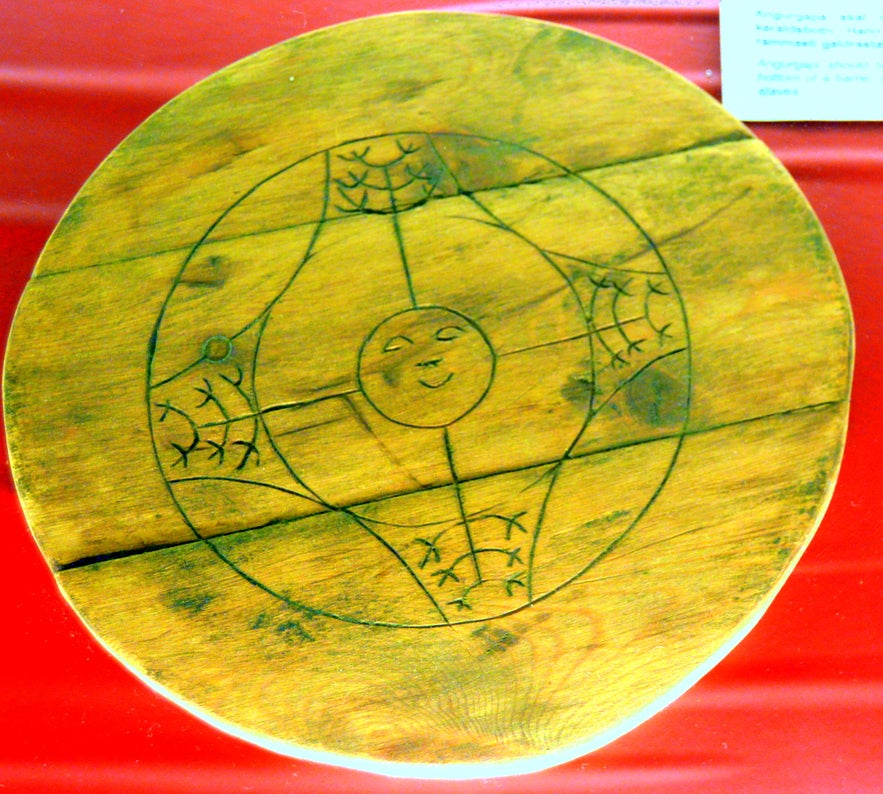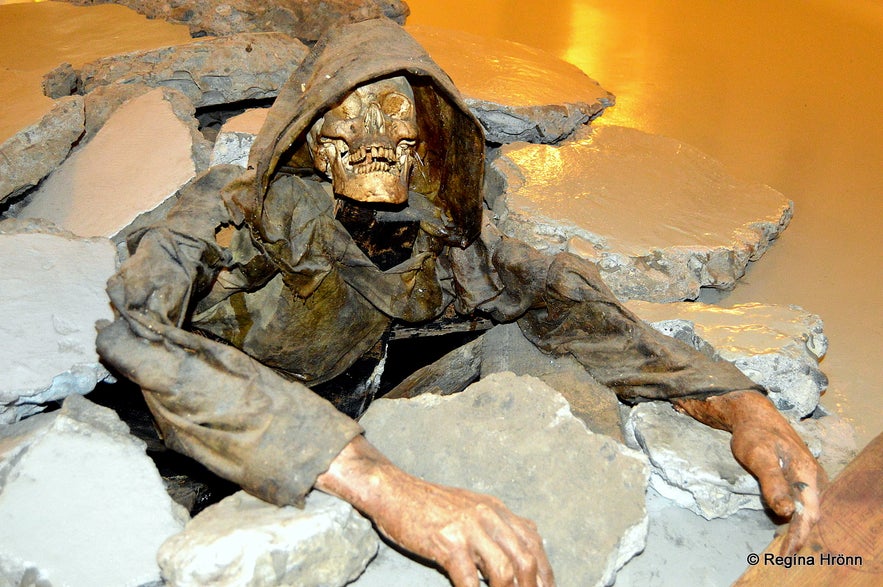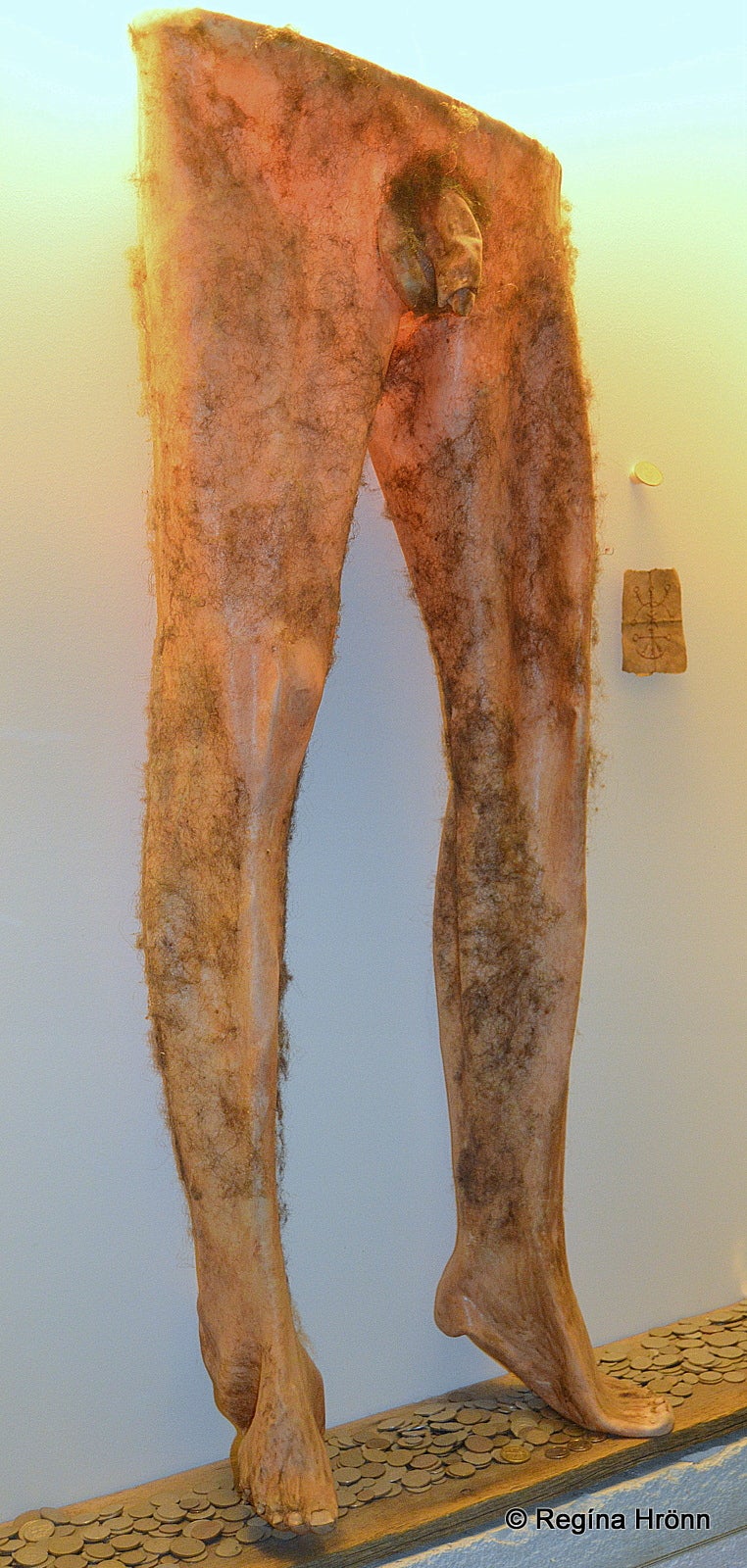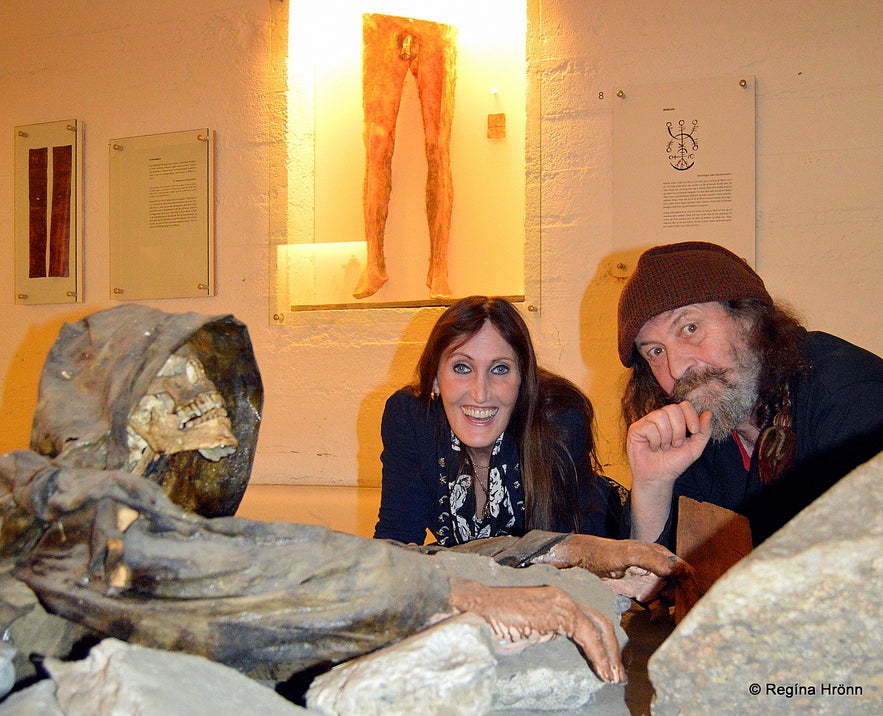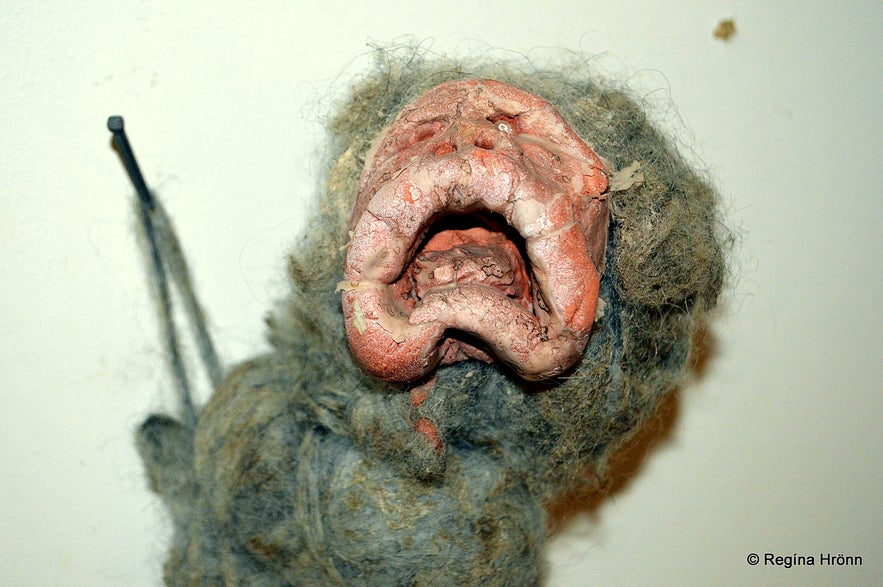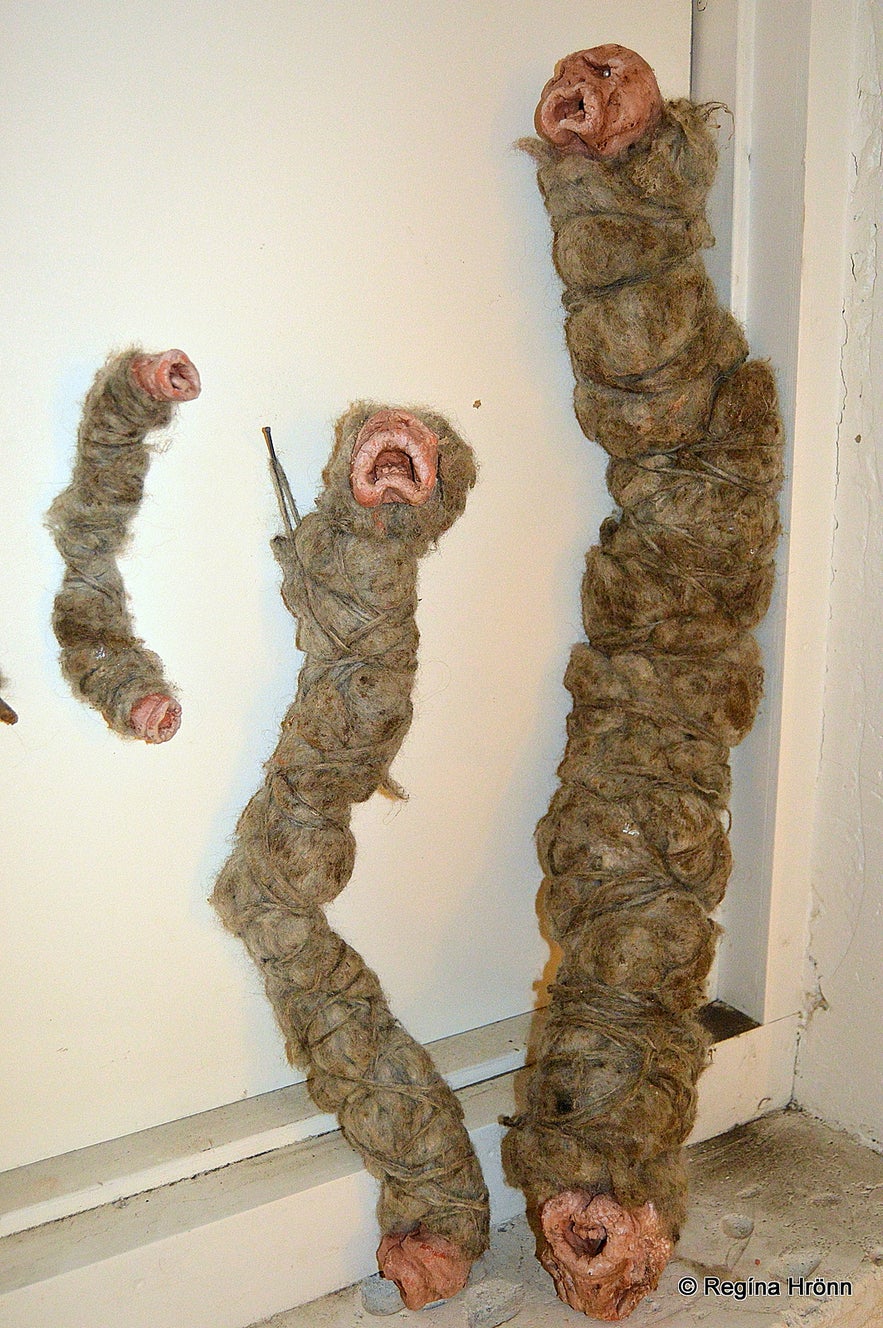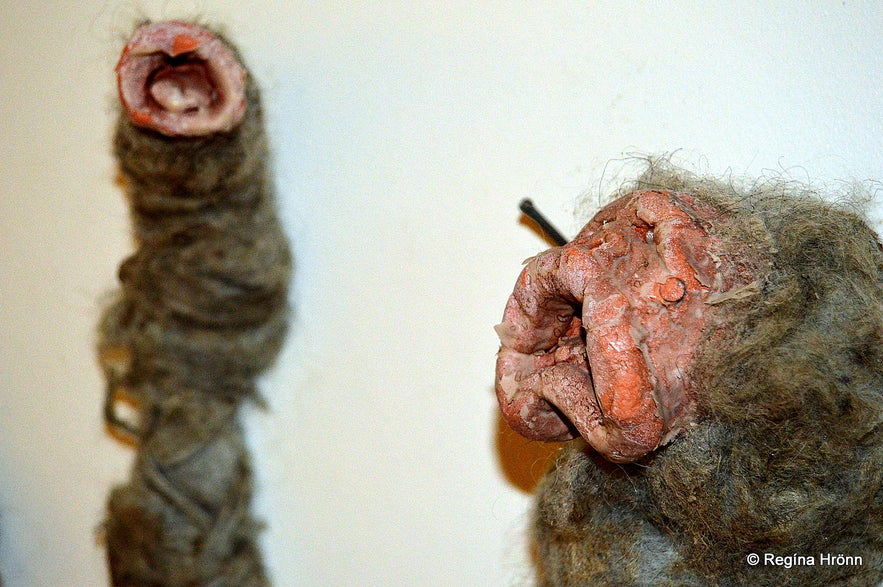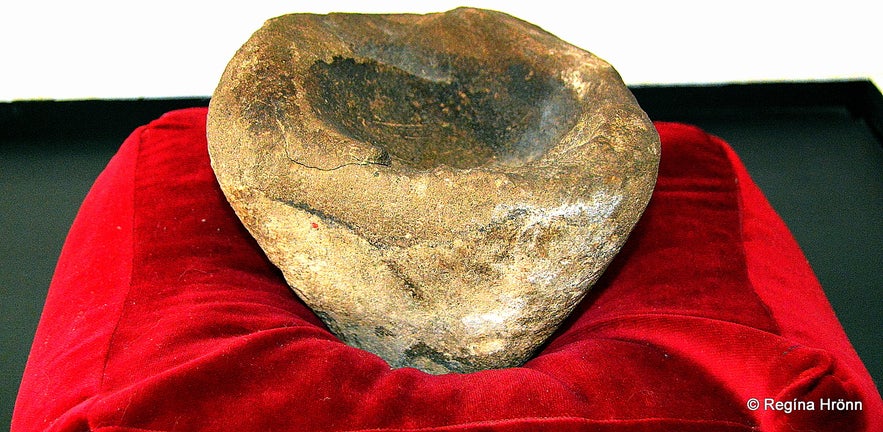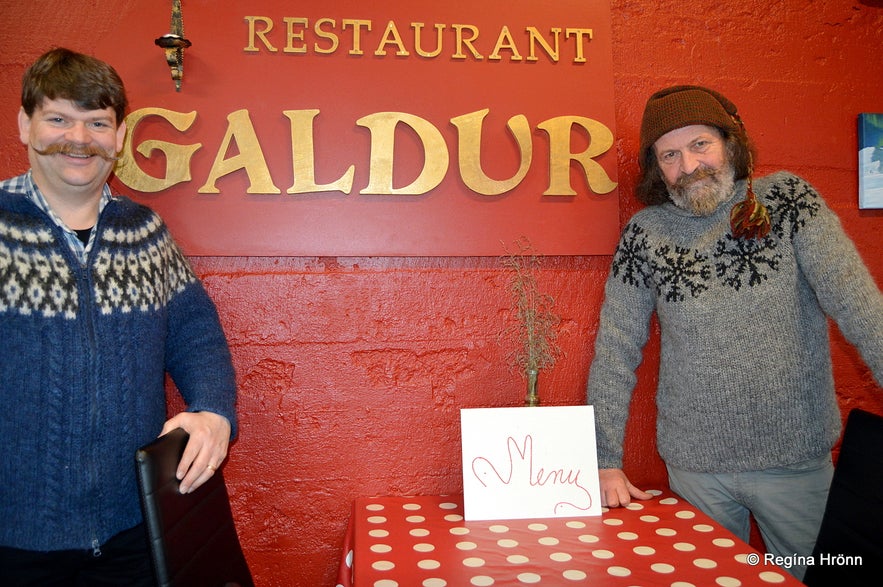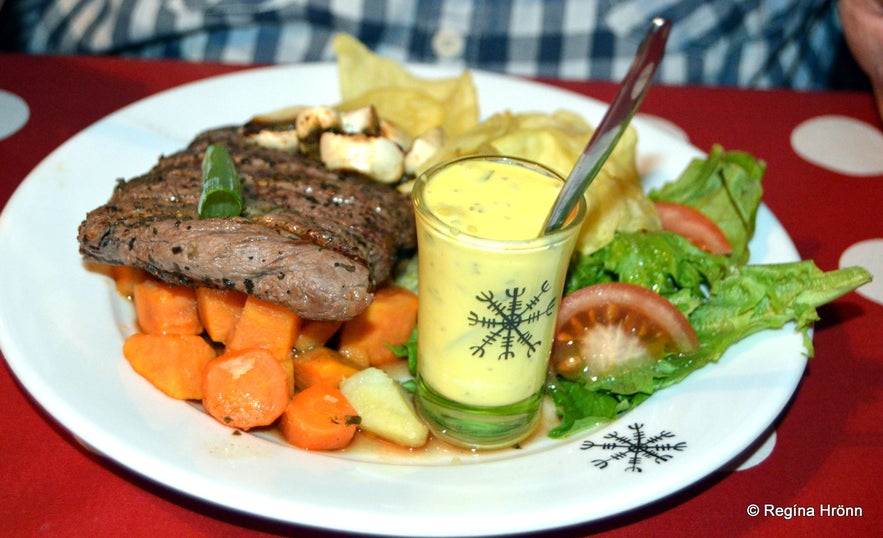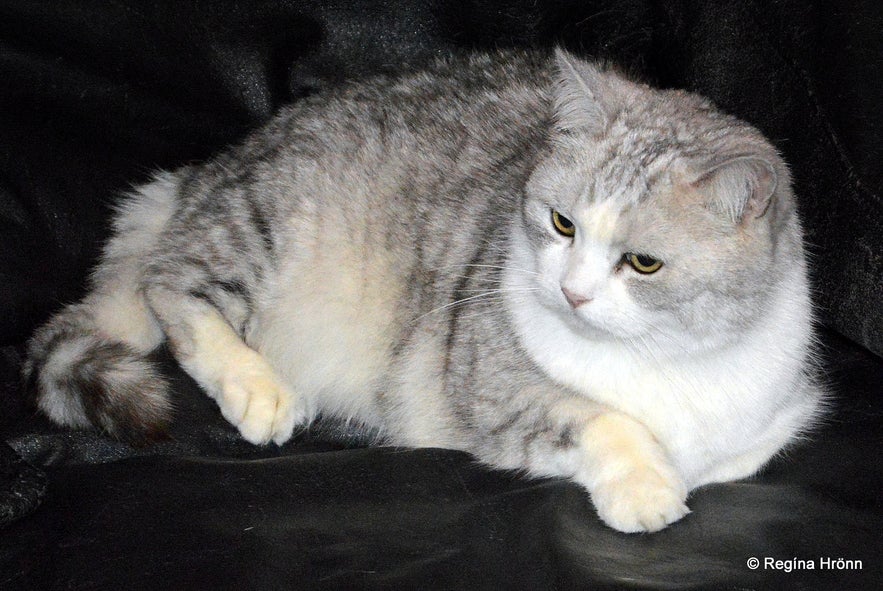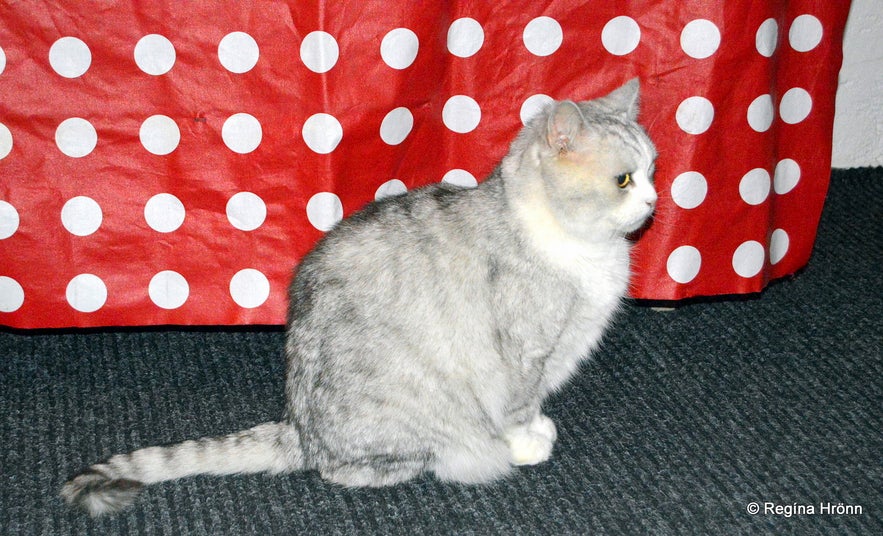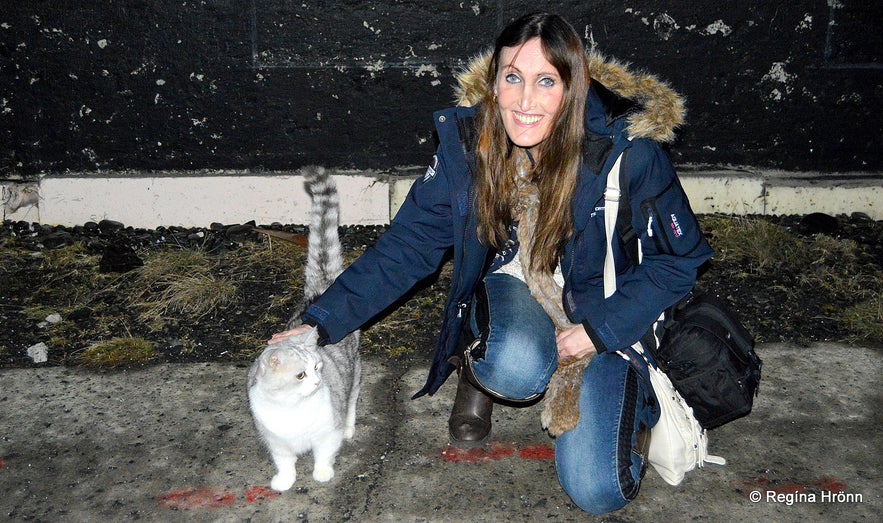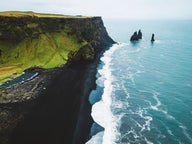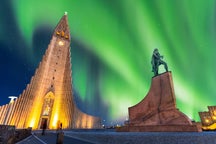A very popular museum is to be found in Hólmavík village, on the east side of the Westfjords Region of Iceland, which is a must-visit while in this area.
This museum is called the Museum of Sorcery and Witchcraft or "Galdrasafnið" in Icelandic.
Let's take a tour of this museum.
Top photo: A creepy guy at the Sorcery museum
Angurgapi magical stave
The museum is on two floors and depicts the history of sorcery, which was seemingly powerful in this area of Iceland called Strandir.
At the museum, you can learn all about Icelandic witchcraft - even how to make yourself invisible! And you will even "see" an invisible boy!
The museum is not for the faint-hearted, and even though I have visited this museum several times, I still get the chills being in there - surrounded by zombies, milk-sucking demons, and magical staves.
Amongst the many magical staves is the one in my photo above, "Angurgapi", which is one of the most potent magical staves in Iceland. It looks so innocent, though.
I almost feel uncomfortable having it here in my travel blog!
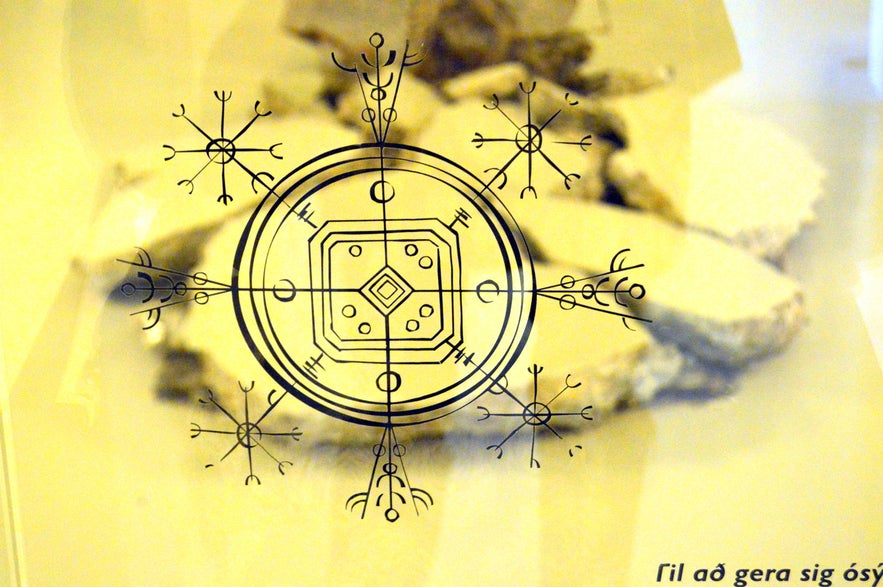
In the year 1652, the first man was burned as a sorcerer in North Iceland. His name was Jón Rögnvaldsson, and he was charged with raising a ghost (zombie) to cause harm to his enemy.
In 1654 at Trékyllisvík in Strandir, three men were burnt at the stake for sorcery. A witch hunt followed, and this period of time in Iceland, from 1654-1690, has been called "Brennuöldin" or the Fire century.
Another 16 men and one woman were burnt at the stake, the last one in 1683.
I am glad I was not alive during these dark ages in Iceland.
The zombie crawling out from the floor!
The scariest museum object is undoubtedly the zombie crawling out of the museum floor.
In some of the photos, the museum curator, the sorcerer Sigurður Atlason, is with me. He is a lovely man and quite a colourful character.
He was even willing to lie down on the floor with me by the zombie to get a good photo for my travel blog.
Sadly, Sigurður died suddenly in November 2018 :( He will be missed.
With the late Sigurður Atlason on the floor, talking to the zombie
It was a strange scene, here I was lying on the floor with a sorcerer next to a zombie, while a magician was taking our photo! Life is sometimes very strange ;)
The Necropants
The necropants at the Museum of Icelandic Witchcraft and Sorcery
Stave for Necropants
Now, this is by far the most infamous piece at the museum - the horrible necropants, which date back to the 17th century.
I found the story of the necropants in Þjóðsögur Jóns Árnasonar - the Compilation of Folklore of Jón Árnason, but I got this English translation from the homepage of the museum:
"If you want to make your own necropants (literally; nábrók), you have to get permission from a living man to use his skin after his death. After he has been buried, you must dig up his body and flay the skin of the corpse in one piece from the waist down. As soon as you step into the pants, they will stick to your own skin.
A coin must be stolen from a poor widow and placed in the scrotum along with the magical sign, "nábrókarstafur", written on a piece of paper.
The magical stave for the necropants
Consequently, the coin will draw money into the scrotum so it will never be empty, as long as the original coin is not removed. To ensure salvation, the owner must convince someone else to overtake the pants and step into each leg as soon as he gets out of it.
The necropants will thus keep the money-gathering nature for generations". - Nice, eh!
The necropants on display at the museum are a replica made from the measurements of a local man at Strandir - the curator of the museum told me that he didn't know if these were his private parts as well, or if they are just made up ;)
With the late Sigurður Atlason at the museum
The news about the necropants has travelled all over the world, and Stephen Fry talked about them in his show QI and claimed that this is how the Icelandic economic system works ;)
The show caused a frenzy, and the museum saw many more visitors after it aired - most of them were looking for the necropants!
There are, of course, many interesting things on display at this museum, but these necropants have become the most infamous ones.
Tilberi - the milk-sucking demon
Tilberi - the milk-sucking demon
There are some horrible-looking creatures at the museum that caught my attention. They are called "tilberi" and are milk-sucking demons! Women were supposed to create tilberi to amass butter.
They would send the tilberi, which had mouths at both ends, to suckle on other farmers' cows until it was filled with milk. It would then return to their "mother" and vomit into the churn for making butter - and their vomit was almost pure butter, albeit a little lumpy!!
I found step-by-step instructions on how to create this demon in Þjóðsögur Jóns Árnasonar - the Compilation of Folklore of Jón Árnason:
"Snakkur or tilberi are made by women in the way that they steal a rib from a corpse at the cemetery. On Whitsunday, they steal a piece of copper, breaking it off from a church clock.
Then they pluck wool from between the shoulders of a newly sheared sheep, which belongs to a widow.
Tilberi - the milk-sucking demons
They then wrap the wool around the human rib and the piece of copper, keeping it between their breasts.
The next time they go to communion, they spit the sanctified wine out and into the wool with the rib and the copper, and the tilberi is thus created.
The tilberi gets its nutrition from suckling on the women. The women are easily recognized by their limp and the sanguine teat-like wart on the inside of their thigh, on which the tilberi suckles.
To get rid of a tilberi: let them pick up all the lamb droppings on three highland pastures and bring them to the women - then the tilberi explodes! (This creature cannot stand the holy number 3).
A bizarre creature, indeed!
From a distance, the tilberi is long and inflated, convex on both ends, and moves very quickly by putting one end at a time on the ground while twisting and turning. The butter of tilberi can be recognized by making the sign of the cross in the butter with a finger, and if it explodes into small pieces, then it is the butter of a tilberi.
Hence, the custom was that when women knead the butter, they make the sign of the cross in the butter with a finger".
(Translated into English from Þjóðsögur Jóns Árnasonar - the Compilation of Folklore of Jón Árnason).
The Ritualistic Stone from Viking Times
The Ritualistic Stone from Viking Times
Resting on a crimson velvet cushion is the only ritualistic stone from Viking times ever found in Iceland.
It is believed to have been used in connection with sacrifices to the Viking Gods, and remnants of animal blood can still be found in the bowl.
This bowl was found in Goðdalur - the Valley of Deity in the Bjarnarfjörður valley in the Westfjords Region. According to folklore, there was a heathen temple in this valley.
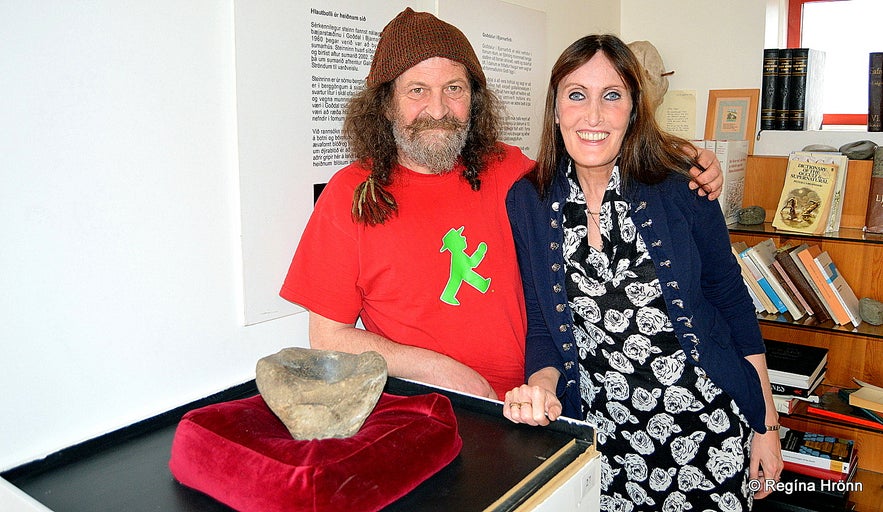
With Sigurður by the ritual stone
There is also a burial mound in this remote valley containing the remains of the Viking Goði.
The story goes that both the heathen temple and the burial mound are jinxed and should never be disturbed.
Forensic tests have been carried out to ascertain that the ancient blood is authentic.
Restaurant Galdur
The magician and the sorcerer
My husband and I were staying in Hólmavík for 3 days as he was taking part in the Children's Cultural Festival of the Westfjords.
We stayed at Steinhúsið, next to the Museum of Icelandic Sorcery and Witchcraft, and decided on having dinner at the Galdur restaurant. This restaurant is located at the museum and was run by Sigurður Atlason.
Sigurður is wearing a woolen sweater in the photo above with magical staves, but these sweaters are for sale at the museum.
Plus many other things with magical staves, like the glass below. Both the sweater and the glass have the Ægishjálmur magical stave - the Helm of Awe (or Helm of Terror); to give one courage and to protect one against abuse of power and dictatorship.
The plates and glasses have magical staves
The first night, we were the only ones dining at the restaurant and had a good chat with the curator. My husband had the beef, which he said was excellent. I have food allergies, so I rarely eat at restaurants. The second night, the restaurant was absolutely packed, which was even lovelier as there was such a good atmosphere in there :)
My husband had the lamb, which he praised; and this man loves his food! The service was fast and friendly, and we felt totally relaxed and at home.
Hippo the Cat
Hippó the Cat at the Museum of Icelandic Witchcraft and Sorcery
Hippó (Hippopotamus) the Cat was Sigurður's cat. This cat had many fans around the world.
Hippó was partly Persian, with beautiful, thick white and grey fur. It was obviously very well kept by its owner, Sigurður.
People who had visited the museum started writing about Hippó on blogs, Facebook, and Twitter, and guests began asking about this lovely cat.
I had read about it on the news, and when I posted photos on Facebook of the Museum of Icelandic Sorcery and Witchcraft, one of my relatives asked me if I had met Hippó.
Hippó the Cat at the museum
She was a personal friend of Sigurður and owns cats that were friends with Hippó. I had forgotten to ask about Hippó, so off I went to the museum again and asked to see the cat.
It was sleeping at home, but Sigurður told me that he would bring it to the museum in the evening.
So finally I met this famous cat when we dined at the museum on our second night in Hólmavík. Other guests at the restaurant at the museum enjoyed Hippó's company as well, petting it and taking photos of it.
Petting Hippo outside the museum
Hippó, the museum cat, lent its name to a charity and served as the protector of funding for Kattholt, our cat shelter. Hippo thus raised ISK 65,000 for homeless cats and helped Kattholt from being closed down.
A postcard with a photo of Hippó was made and sold, and the profits went to Kattholt.
People from all over the world took photos of Hippó and sent them to the museum, and one of these photos was chosen for the postcard.
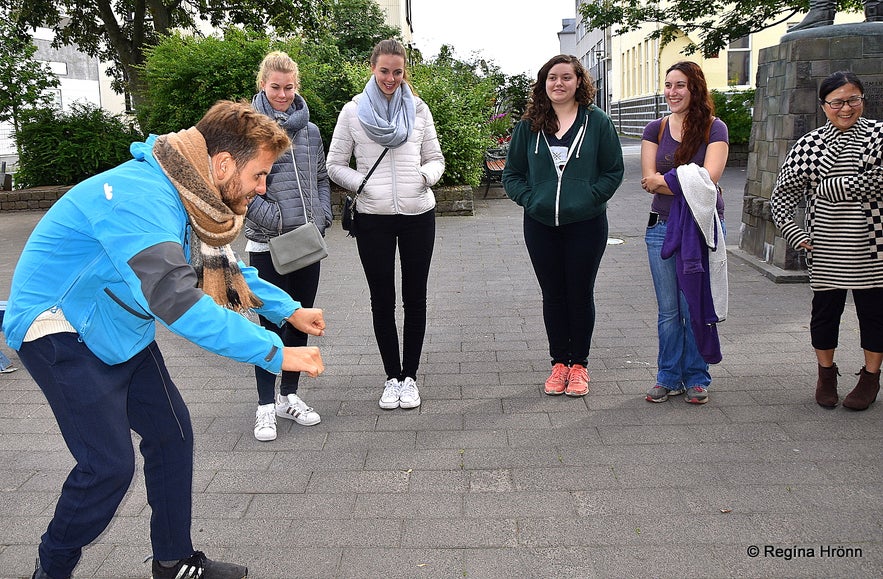
Our Reykjavík guide showed us how to wake up a zombie
Look up the Strandagaldur's website to see the opening hours and entrance fee.
If you want to join a really cool guided walking tour in Reykjavík, I recommend the Icelandic Mythical Walk | Trolls, Elves & Hidden People, where you will learn bout the necropants and how to wake up a zombie, amongst many other interesting stories from Icelandic folklore.
See also my travel blogs:
Hólmavík in the Westfjords Region of Iceland - the Sorcery Town!
The Mystical Sorcerer's Cottage in Bjarnarfjörður in the Westfjords Region - Kotbýli kuklarans
The remote Strandir in the Westfjords Region of Iceland - Stillness & Sorcery
Hólmavík is located 230 km away from Reykjavík. You can rent a car in Reykjavík and drive up there in a day.
Have a lovely time at the Sorcery museum and at Strandir :)

